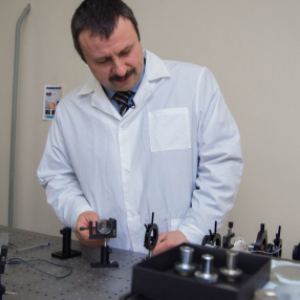Samara University’s scientists has produced an experimental model of an analog photonic computing system capable of processing video data hundreds of times faster than modern digital neural networks based on traditional semiconductor computers. The optical neural network based on the photonic computing system will be able to analyze the incoming video stream in real time and almost instantly recognize and find in it specified objects and images. Along with analyzing the “picture” from a conventional video camera, the development also makes it possible to quickly process data obtained by hyperspectrometers — devices that see reality in multichannel spectral imaging, and allow detecting objects invisible to conventional means of observation.
The project is being implemented as part of the scientific program of the National Centre for Physics and Mathematics (NCPM). Researching in framework of this project is funded by the Ministry of Science and Higher Education of the Russian Federation and the “Rosatom” State Corporation.
“The assembly of the experimental model of the analog photon computing device has been completed, all parts and components have been installed, now the entire system will need to be configured, calibrated and adjusted. Some changes were made to the design, and a new laser was installed. Processes of configuring and calibrating are expected to be completed in September, after which, till November of this year, we plan to conduct a series of experiments aimed at shoing in practice what the experimental model of the computing device is capable of. During the experiments, data obtained from the dual-band hyperspectrometer, also developed at our University, will be analyzed, among other things. The ability to analyze hyperspectral data can be called a key feature of our computing device. It can recognize and classify specified objects in the video stream at almost the speed of light — hundreds of times faster than modern digital neural networks based on semiconductor computers, and this speed of analysis will allow very fast processing hyperspectral data, which initially are very significant arrays of information,” said Roman Skidanov, Professor at Samara University’s Department of Engineering Cybernetics, Doctor of Physical and Mathematical Sciences.
The experimental computing device is compact enough and can fit into a case of the size of a small computer system unit. For now, the developers have decided to place the optical part of the device and its electronic components separately. In 2023, at the University, a demonstration sample of the photonic computing device was assembled and, during experiments, confirmed operability of the selected device circuit. During the first experiments, the demo model showed recognition reliability of 93.75%. The new, experimental sample uses components with improved parameters, and the other laser — diode-type one — is installed, it is more compact and has less coherence, which can also improve recognition accuracy. In 2025, Samara scientists plan to manufacture and test a prototype computing device, which may become almost a pre-production one.
In addition to high performance and wide spectral range, analogue optical computing systems also have advantages, such as complete protection from electromagnetic disturbances, low energy consumption and the option of parallel data processing. The system scheme that allows for fully optical processing of incoming data, was first proposed in 1958. This area actively developed in the 80s of the last century, but then using the devices almost ceased, because of both their bulkiness and development of digital technology. In recent years, in various countries of the world, this field of applied research has become increasingly relevant, due to new materials and compact special-structure optics to be designed.
For reference:
In hyperspectral imaging or hyperspectral Earth remote sensing conducted from a UAV or a space satellite, each pixel of the resulting image is represented as a full or continuous spectrum, which allows identifying spectral properties of the desired objects, as well as detecting objects invisible when other means of observation applied, during processing the data obtained.
For example, hyperspectrometers can efficiently detect greenhouse gases by recording methane and CO2 emissions, as well as conduct geological exploration of hard-to-reach areas, identifying from space spectral signatures of various minerals, including those that indicate possible location of oil and natural gas deposits. Hyperspectrometers can monitor more efficiently and accurately occurrence of forest fires and the condition of forests and agricultural crops, help calculate vegetation indices and even detect from outer space stress in plants.
Samara University is a participant in the National Project “Science and Universities.”
 RU
RU  EN
EN  CN
CN  ES
ES 